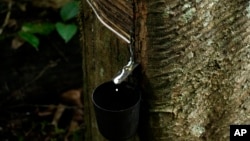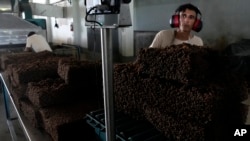Rubber tapper Raimundo Mendes de Barros prepares to leave his home, surrounded by rainforest, to run an errand in the Brazilian Amazon town of Xapuri. He slips his long, scarred 77-year-old feet into a pair of slippers made by Veja, a French brand.
At first glance, expensive urban sneakers with white accents seem at odds with the muddy tropical forest. But distant worlds have converged to produce soles made from native Amazonian rubber.
Veja works with a local cooperative called Cooperacre, which has revitalized the production of a sustainable forest product and improved the lives of hundreds of rubber tapping families. It is a project that, although modest in scale, offers a real-life example of how to live sustainably in the forest.
“Veja and Cooperacre are doing fundamental work for us who live in the jungle. They are making the young come back. They have revived the hope of working with rubber,” Rogério Barros, 24-year-old son of Raimundo, told The Associated. Press while demonstrating how to bore a rubber tree in the family’s grove in the Chico Mendes Extractive Reserve. Extractive reserves in Brazil are government-owned land set aside for people to earn a living while keeping the forest standing.

A rubber tree is prepared for rubber extraction in the Chico Mendes Extractive Reserve, Acre state, Brazil, on December 6, 2022.
Rubber was once central to the Amazon economy. The first boom occurred at the beginning of the 20th century. Thousands of people migrated inland from Brazil’s impoverished northeast to work in the jungle, often in slave-like conditions.
That boom ended abruptly in the 1910s when rubber plantations began producing on a large scale in Asia. But during World War II, Japan cut off the supply, prompting the United States to finance the restart of rubber production in the Amazon.
After the war, Amazon’s latex trade fell again, even as thousands of families continued to work in poor conditions for the rubber bosses. In the 1970s, these relatively wealthy people began selling land to ranchers in the south, although, in most cases, they did not actually own it, but only held concessions because they were well connected to government officials.
These land sales led to the large-scale expulsion of rubber tappers from the forest. This loss of livelihoods and deforestation to make way for cattle ranching is what prompted the famous environmentalist Chico Mendes—together with a cousin of Barros—to found and lead a movement of rubber tappers. Mendes would be assassinated for his work in 1988.
After Mendes’ murder, the federal government began creating extractive reserves so that the forest could not be sold to make way for cattle. The Chico Mendes Reserve is one of them. But the story did not end with the creation of the reserves. Government attempts to promote latex, including a state-owned condom factory in Xapuri, failed to generate a reliable income.
What sets Veja’s operation apart is that rubber tappers are now paid well above commodity prices for their rubber. In 2022, the Barros family received US$4.20 per kilo of rubber extracted from their orchard. Before, they earned a tenth of that amount.
This price that the shoe company Veja pays to collectors includes bonuses for sustainable harvests plus recognition of the value of preserving the forest, explains Sebastião Pereira, in charge of Veja’s Amazon rubber supply chain. Rubber tappers also receive federal and state benefits per kilo.
Veja also pays bonuses to collectors who use best practices and to local cooperatives that buy directly from them. The criteria range from zero deforestation to proper management of rubber trees. The best producers also receive a pair of shoes as a prize.
Veja rubber is produced by some 1,200 families from 22 local cooperatives spread across five Amazon states: Acre, home of the Chico Mendes Extractive Reserve, Amazonas, Rondonia, Mato Grosso and Pará.
All the rubber goes to the Cooperacre plant in Sena Madureira, in the state of Acre, where the raw material is cut, washed, crushed into smaller pieces, heated, weighed, packaged and finally sent to the factories that Veja contracts in the industrialized state of Rio Grande Sul. thousands of miles to the south, as well as to the state of Ceara, in northeastern Brazil.

Employees work at a rubber industrial plant of the cooperative called Cooperacre, in Sena Madureira, Acre state, Brazil, on December 9, 2022.
From there the shoes are distributed to many parts of the world. Over the last 20 years, Veja has sold more than 8 million pairs in various countries and maintains stores in Paris, New York and Berlin. The amount of Amazon rubber it buys has skyrocketed: from 5,000 kilos (11,023 pounds) in 2005 to 709,500 kilos (1.56 million pounds) in 2021, according to company figures.
However, it has not been a game changer for the forest in the Chico Mendes Extractive Reserve, where nearly 3,000 families live. The illegal movement of cattle, an old problem, has rebounded. Deforestation there has tripled in the past four years, amid the policies of former President Jair Bolsonaro, who was defeated in his re-election bid and left office late last year.
Cattle have long since replaced rubber as Acre’s main economic activity. Almost half of the rural workforce in the state is employed in cattle raising, where only 4% live off forest products, mainly chestnuts.
According to an economic study by the Federal University of Minas Gerais, 57% of Acre’s economic production comes from livestock. Rubber constitutes less than 1%.
Surrounded by cattle pastures and a paved road, the entry point for deforestation, Chico Mendes has the third highest rate of deforestation of any protected reserve in Brazil.
Increasing cattle pressure on the reserve, which has already lost 9% of its original forest cover, even led Veja to set up its own satellite monitoring system.
“Our platform shows a specific region where deforestation is rampant. So we can go there and talk. But we are aware that our role is to offer an alternative and raise awareness,” Pereira told the AP in a telephone interview. “We are careful not to cross the line, as the public authority should be the one to enforce the law.”
According to Roberta Graf, who heads the Acre branch of the association of federal environmental officials, Veja’s experience is essential, as it shows a path to living within extractive reserves sustainably. But to achieve that, she argues, requires a concerted effort that includes government at different levels, nonprofit and grassroots organizations.
“The communities of the jungle still appreciate the exploitation of rubber. They enjoy making a living with latex,” he told the AP in an interview at his home in Rio Branco, the capital of Acre. “There are many forest products: copaiba, andiroba (vegetable oils), chestnuts, wild cocoa, and seeds. The ideal would be to work with everyone according to what each reserve can offer”.
Source: news.google.com
